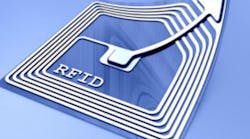Line item RFID is showing the capability to increase supply chain efficiency.
According to a new research from the Auburn University RFID Lab and GS1 US brand owners and retailers using Electronic Product Code (EP)-enabled radio frequency identification (RFID) to optimize inventory management and reconcile product shipments are capable of achieving 99.9 percent order accuracy. Using item-level RFID technology, retailers can decrease out-of-stocks, improve loss detection, boost sales margins and expedite returns—just to name a few of the technology’s benefits.
Measuring a sample of more than 1 million items from five leading retailers and eight brand owners, the study also found that when RFID was not implemented, 69 percent of orders shipped and received from brands to their retailer partners contained data errors. These errors were revealed in picking, shipping, and receiving, resulting in inventory inaccuracies and costly chargebacks from the retailers to the brand owners. Additionally, the research exposed that brands and retailers generally accept these process errors and attempt “work-arounds,” which often result in additional errors and costs.
“This study should cause retail industry stakeholders to consider the immediate positive impact item-level RFID can have on supply chain efficiency. Retailers and brands have a tremendous opportunity to eliminate errors, as the lack of inventory accuracy is a preventable problem that can be solved with greater automation through RFID,” said Dr. Bill Hardgrave, provost and senior vice president for academic affairs, Auburn University.
“Retail today is ultra-competitive—the right product needs to be in the right place at the right time for the consumer. Deploying item-level RFID improves the efficiency, precision and reliability of the entire retail supply chain, helping brands and retailers exceed consumer expectations and build loyalty,” said Michelle Covey, vice president of retail apparel and general merchandise, GS1 US.
The EPC/RFID Retail Supply Chain Data Exchange Study, also dubbed “Project Zipper,” surveyed the effectiveness and business value of item-level RFID tagged items as they travel throughout the supply chain, from a brand owner to a retailer. It examined the flow of information between the brands and retailers over a one-year period from June 2017 to June 2018. During this time, the RFID Lab team examined the data obtained from barcode scans at the brand owners’ distribution centers, and barcode data at the retailers’ distribution centers, and compared them with data captured via RFID tags.
The study will continue with a Phase 2 analysis that will investigate the causes of errors, the consequences of work-arounds and additional use cases for traceability and authenticity. Researchers anticipate Phase 2 will be completed in mid-2019.
For more information about the Auburn University RFID Lab research, please visit https://rfid.auburn.edu/. To read the full study and to learn more about GS1 US and industry implementations of RFID, please visit www.gs1us.org/projectzipper.



